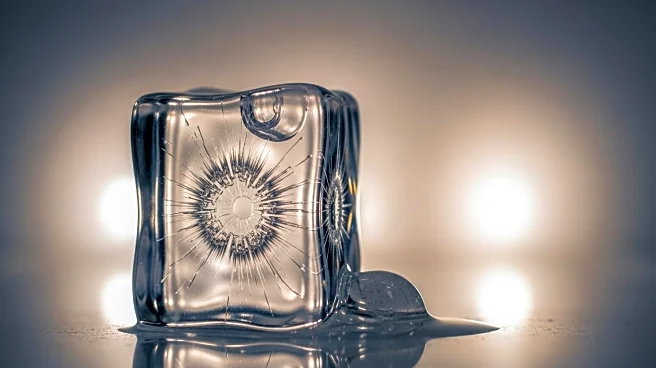What is the story about?
What's Happening?
Recent scientific research has delved into the complex crystallization pathways of high-density water (HDW) as it transitions through various ice phases, particularly ice XXI, at room temperature. The study highlights Ostwald's step rule, which suggests that metastable intermediate phases (MIPs) often form before reaching a thermodynamically stable phase. The research identifies multiple crystallization pathways, influenced by structural similarities between liquids and MIPs, kinetic competition, and entropy production. The study uses molecular dynamics simulations to explore the structural evolution of HDW under pressure, revealing transitions to very-high-density water (VHDW) and subsequent formation of ice XXI. These findings provide insights into the nucleation competition between crystal phases, driven by differences in Gibbs free energy and interfacial free energy.
Why It's Important?
Understanding the freezing-melting pathways of high-density ice has significant implications for planetary science and materials research. The study's findings could enhance knowledge about the behavior of water under extreme conditions, relevant to large ocean worlds and icy satellites. This research may also inform the development of new materials with unique properties, as the structural evolution of water under pressure can influence crystallization pathways. The insights gained could lead to advancements in fields such as cryogenics, climate science, and the study of extraterrestrial environments, where high-pressure ice phases are prevalent.
What's Next?
Future research may focus on further exploring the structural evolution of HDW and VHDW under varying pressures and temperatures. Scientists could investigate the potential applications of these findings in developing new materials or understanding planetary processes. Additionally, the study opens avenues for examining the role of local structural changes in influencing crystallization pathways, which could lead to novel insights into the behavior of water and other substances under extreme conditions.
Beyond the Headlines
The study's exploration of multiple crystallization pathways highlights the complexity of phase transitions in high-density ice, which could have broader implications for understanding the behavior of other substances under similar conditions. The research underscores the importance of considering structural evolution and nucleation competition in studying phase transitions, potentially influencing future scientific inquiries into the nature of matter.
AI Generated Content
Do you find this article useful?















